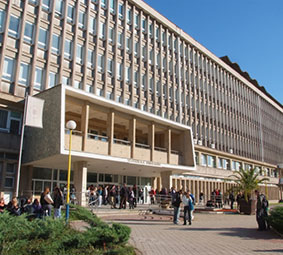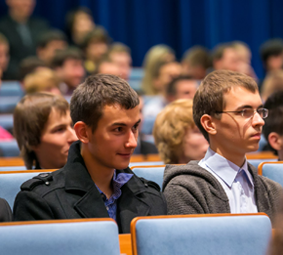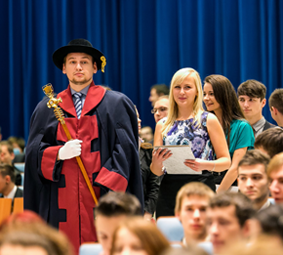Projects
|
Project name |
Project description |
|---|---|
| Promoting the interconnection of Computer and Software Engineering using the KPIkit |
|
| Semantic Modeling of Component-Based Program Systems |
The main goal of this project is to investigate the construction and behavior of component-based systems to ensure their reliability and desired behavior. To ensure the reliable execution of a complex program system composed of components, not only its static construction but also its dynamic behavior plays an important role. Thus the meaning of the basic concepts has to be precisely understood and rigorous rules have to be followed. However, while the construction of component-based program systems is well described in various publications with respect to practical aspects for working programmers, only a few publications define the construction of component-based systems formally. This research is based on the expertise of the Slovak partner on the categorical semantics of programs, on the expertise of the Austrian partner on logical system modeling and analysis, and on the fruitful cooperation of both partners in a previous collaboration project. |
| Setting the trends in IoT education |
This project addresses the development of skills involving the emerging Internet of Things (IoT) (also known as Industry 4.0)
technologies. The main focus falls on training, teaching and learning activities that better prepare the future IoT educators and
instructors at the vocational and higher educational levels, and also indirectly, the users/developers/entrepreneurs/innovators that
will shape the future of IoT. The project focuses on the development of core educational materials and of an open online community
to consume, share, review and enhance these materials. This will ensure a dynamic IoT educational platform where persons
interested in this field will interact directly.
|
| Towards a Software Engineering Discipline for Green Software |
The goal of this project is to study and propose novel techniques to provide programmers with models that will allow them to reason about their programs in terms of energy consumption. Moreover, we aim to develop tools, like energy profilers, energy smell detectors, energy refactorings, energy testing frameworks, and energy optimizations, so that abnormal energy consumption can be related to a program’s source code and optimized. We will validate such techniques and tools with real-world applications. |
| Towards an ecologically valid symbiosis of BCI and head-mounted VR displays: focus on collaborative post-stroke neurorehabilitation (ReHaB) |
We propose a user-friendly wearable low-power smart BCI system with an ecologically valid VR environment in which both the patient and therapist collaboratively interact via their person-specific avatar representations. On the one hand, the patient voluntarily, and in a self-paced manner, manages their activity in the environment and interacts with the therapist via a BCI-driven mental imagery process. This process is computed and rendered in real-time on an energy efficient wearable device. On the other hand, the therapist's unlimited motor and communication skills allow him to fully control the environment. Thus, the VR environment may be flexibly modified by the therapist allowing for different occupational therapy scenarios to be created and selected following the patient's recovery needs, mental states, and instantaneous responses. |
| Update of computer networks curricula based on needs of practice |
The objective of this project is to update computer networks curricula at three Slovak technical Universities based on actual needs of practice. A dynamic development in the fields of network technologies and updated needs of industrial certification require a change of the content scope of lecturing and practical trainings. The secondary goal of this project is to create a cooperation platform among FIIT STU, FRI UNIZA, and FEI TUKE for exchanging content bases, knowledge, pedagogues, and students by means of common courses, summer schools, and practically oriented seminars and trainings. The achievement of this project and cooperation is a higher quality product -student with a high level of proficiency, better prepared for practice. The mutual exchanging of pedagogues and PhD students will support mutual ties and will reinforce the possibilities of the future scientific and pedagogical cooperation. This project will establish a new shared educational content for university students, implement into the education new items of multimedia content, collaborative tools and it will improve practical trainings as a precondition of better preparation of graduates for practice. |
| ViLMA: Virtual Laboratory for Malware Analysis |
The project aims to provide an innovative learning environment for computer security and research in the field of malicious software. Students will address the issue of malicious software at different levels, such as operating systems, computer networks, programming and reverse engineering. Innovative learning environment is based on a separate virtual platform, with the possibility of experimentation and examination of any attacks and threats without restrictions. Laboratory tools and resources allow students practical familiarity with the current trends in computer security and malicious software detection. |
| Virtual-reality technologies in the process of handicapped persons education |
The project focuses on the use of advaced methods and virtual reality technologies as progressive technologies in HCI (Human Computer Interaction) context for better, easier, faster and more attractive understanding of handicapped peoples education in those directions, which are characterized by tighter concepts. The project is a conceptual continuation of the previous pilot project. First goal is the creation of experimental workplace for validation of these technologies with subsequent impact to special pedagogical praxis. Next goal is a creation of software and support means of presentations either for desktop computers or mobile devices and the creation/extension of web page to access the developed software, procedures and examples. Particular attention is given to link these technologies with the educational process in the hearing-impaired persons and persons with multiple disabilities. It is assumed that this way will get better, faster and easier to understand the basic communication methods for these peoples, it increase their ability to correct practical application and integration into modern information society. |
Pages
- « first
- ‹ previous
- 1
- 2
- 3
- 4



















